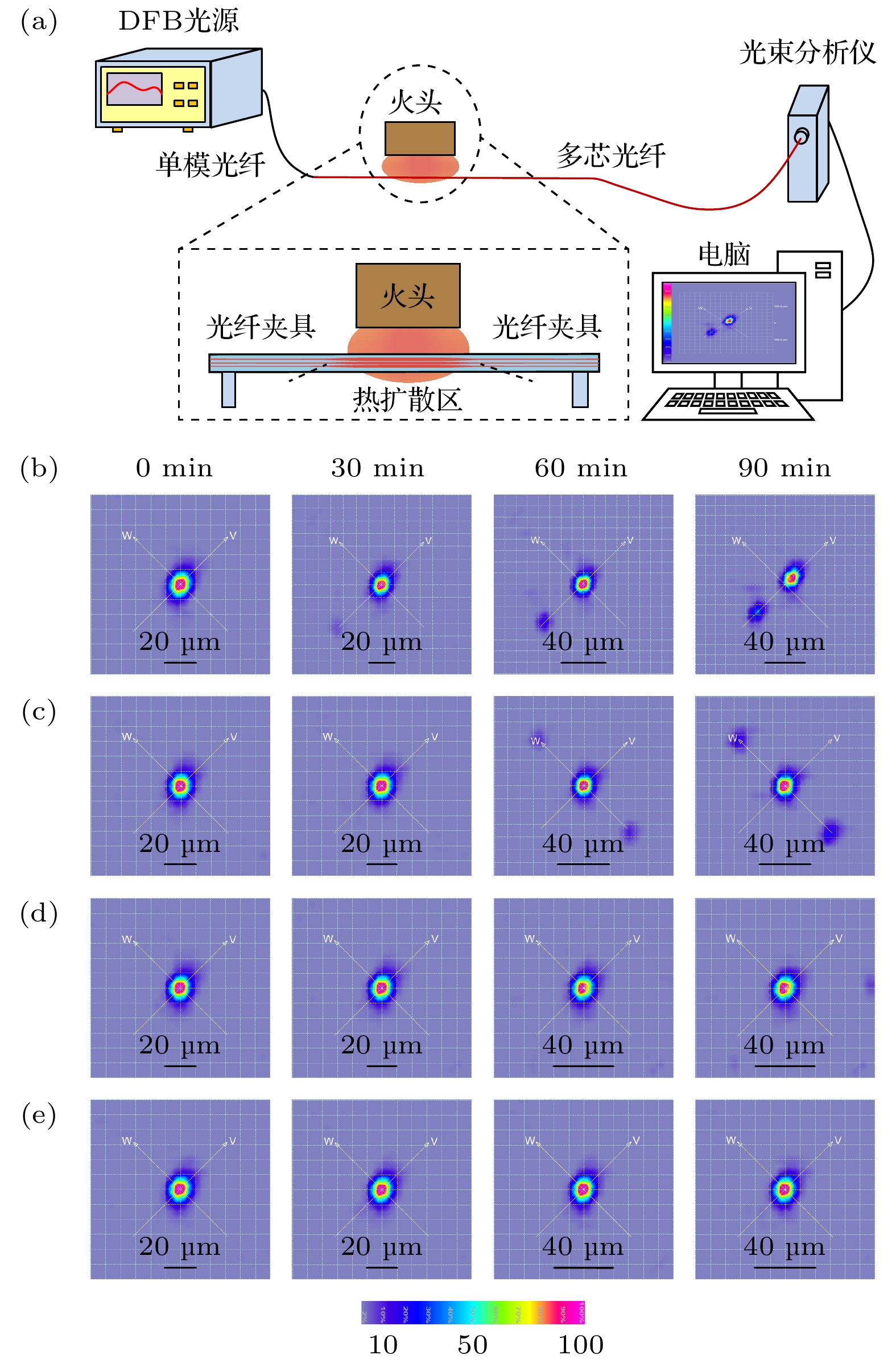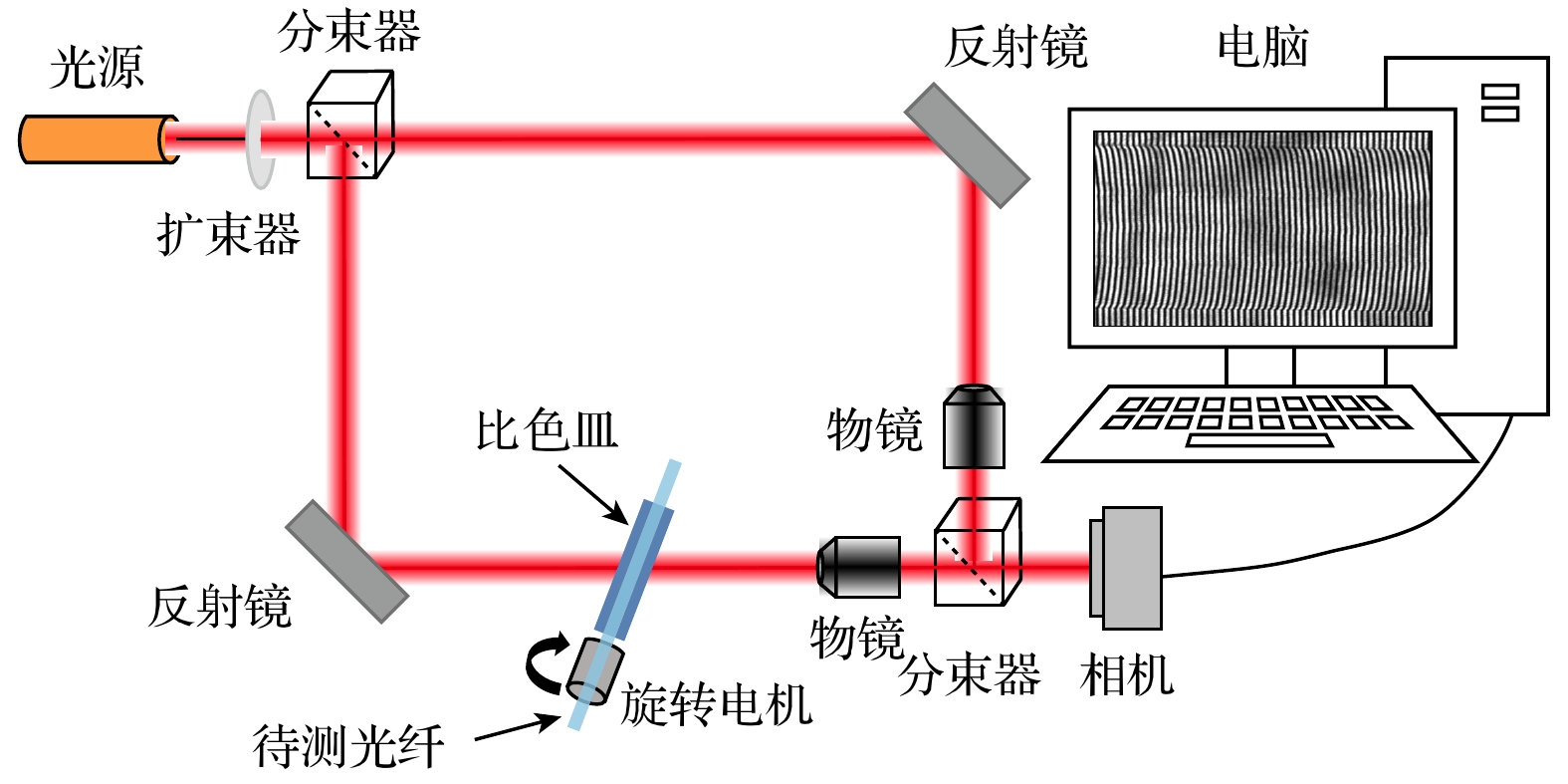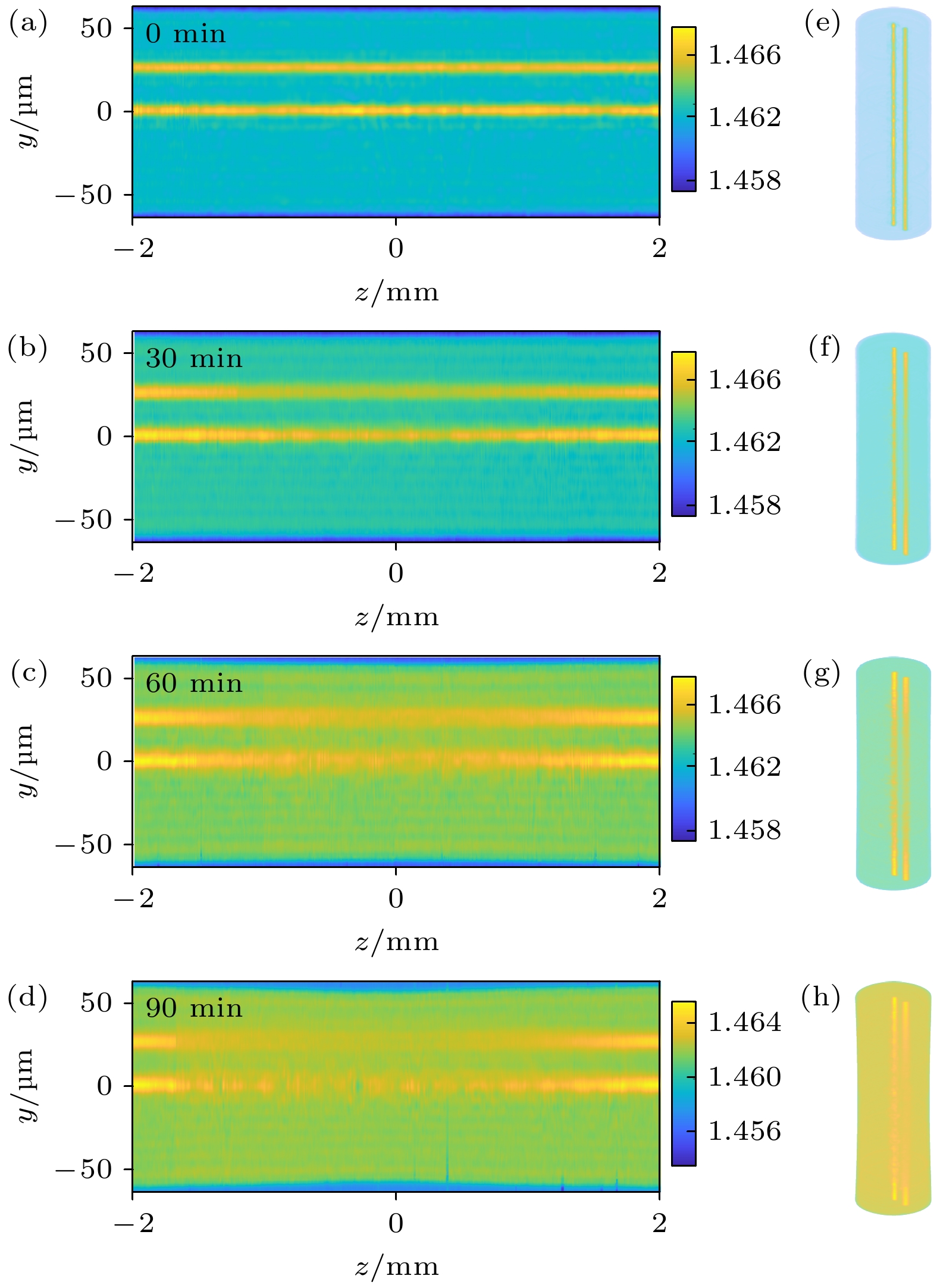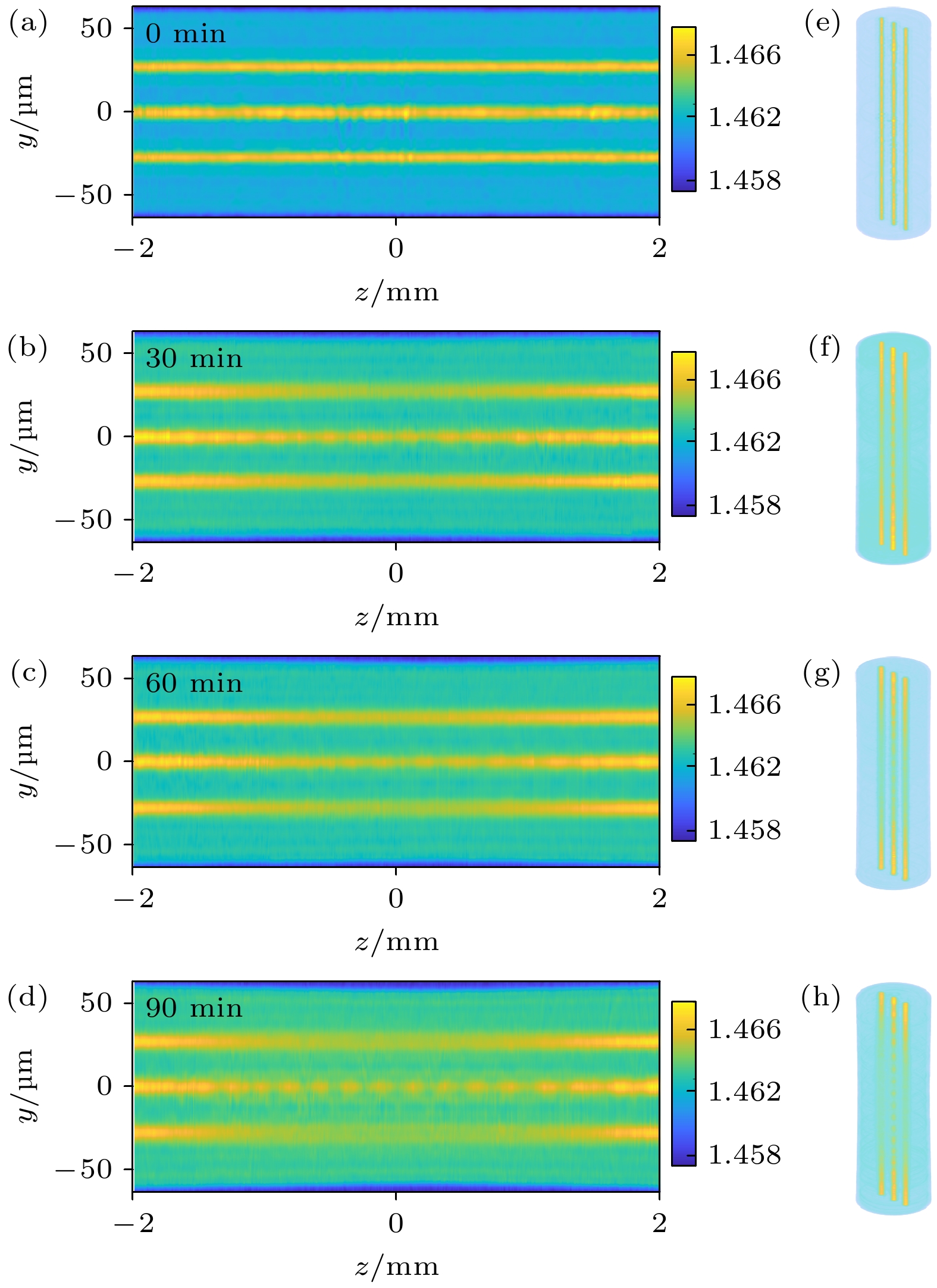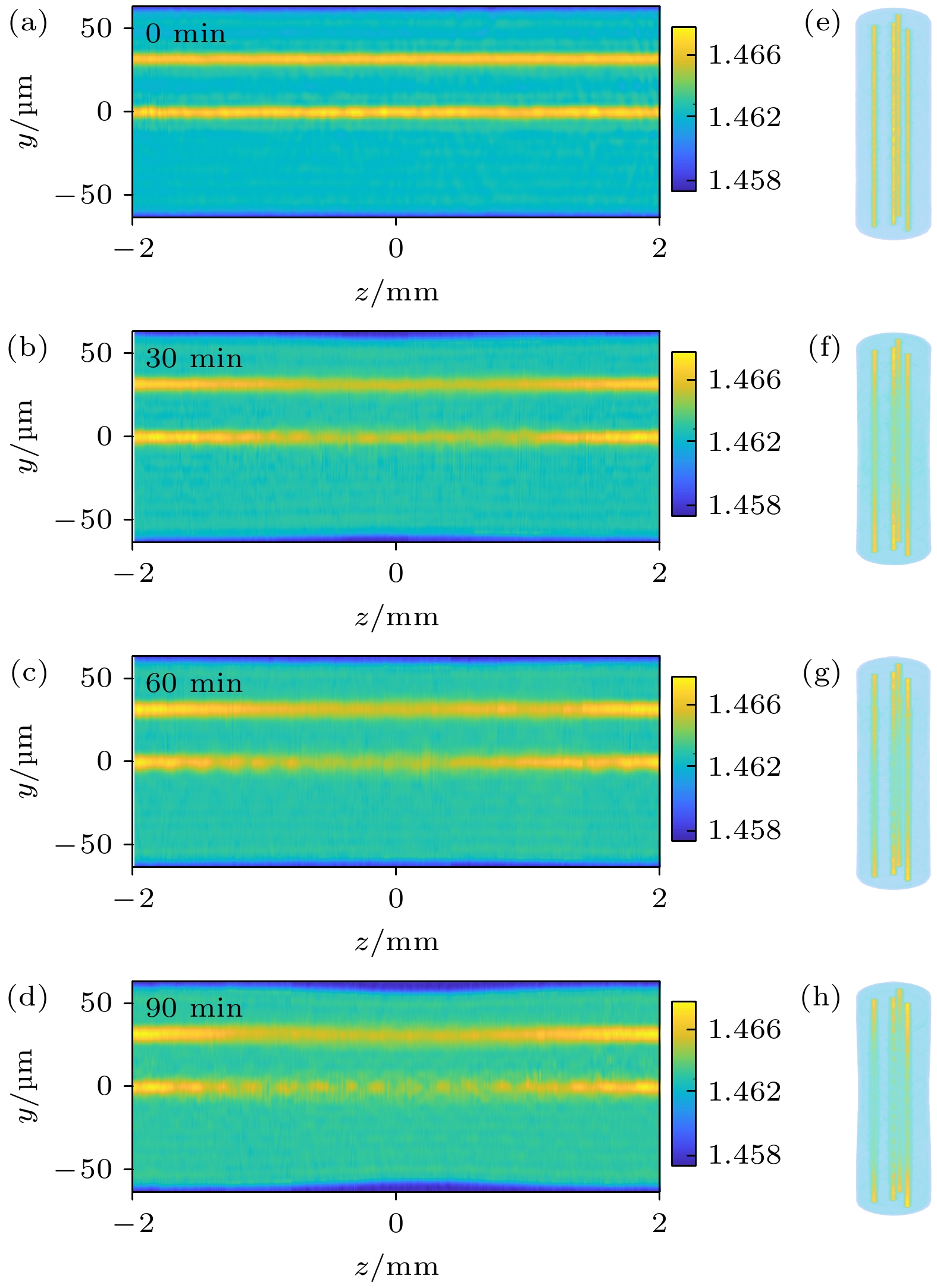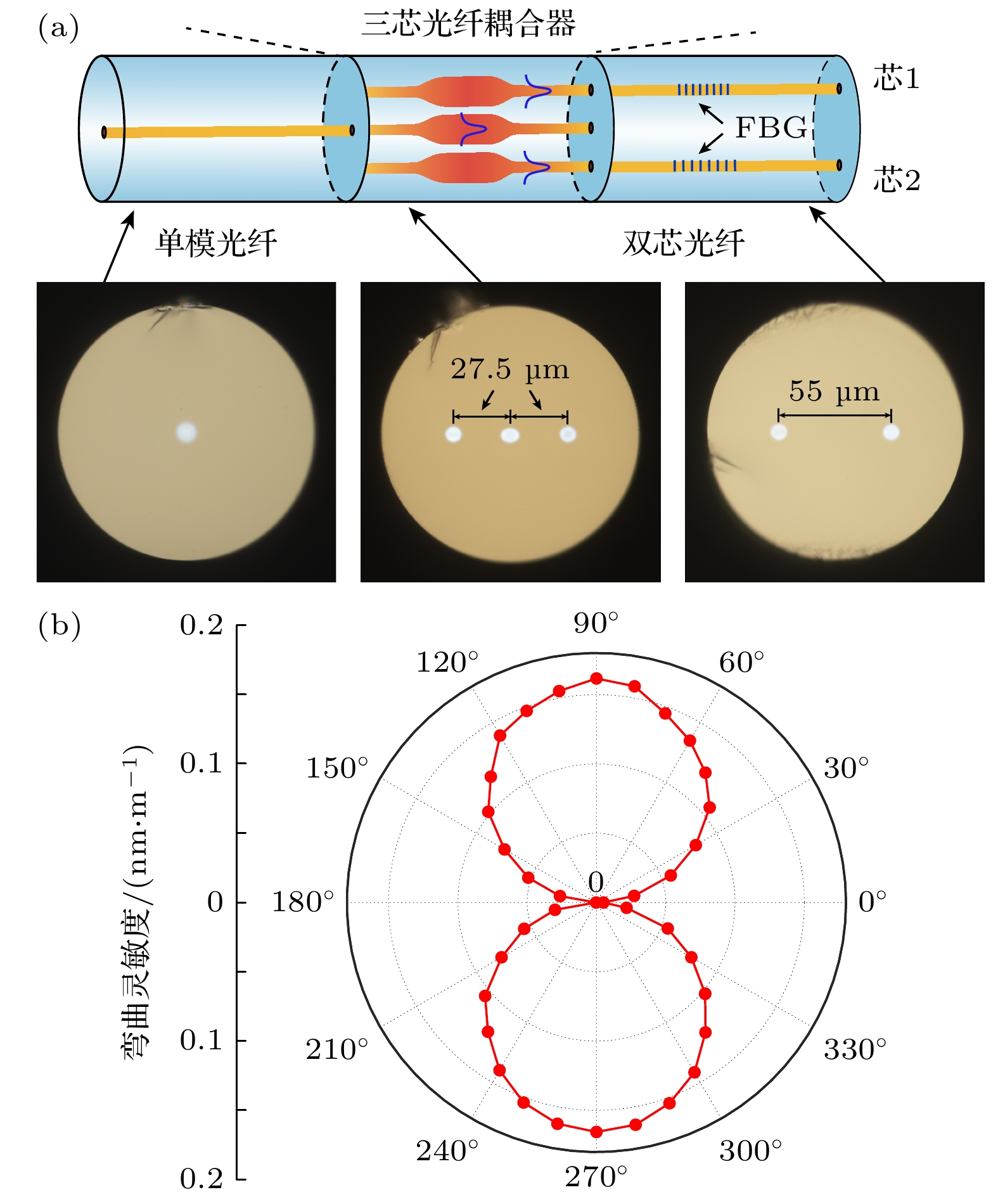-
For discrete optical systems integrated into optical fibers, the optical fields of the individual waveguides are coupled and correlated with each other. This paper studies how to adjust the refractive index of discrete waveguides by thermal diffusion, so as to enhance the coupling between discrete waveguides, and also constructs the discrete waveguide thermally diffused model and the thermally diffused coupling model of twin-core and three-core fibers. The multicore fiber is heated different times by a hydrogen-oxygen flame, and the outgoing light field at the end face of the optical fiber is monitored at the same time. Then, the three-dimensional refractive index measurement results of the thermally diffused multicore fiber verify the feasibility of thermal diffusion technology to change the refractive index of discrete waveguides for coupling. Thermal diffusion technology can be used to fabricate multicore fiber couplers. By combining multicore fiber and core-by-core inscribed fiber Bragg grating technology and by using thermal diffusion technology, the single-channel sensing measurement can be realized. The method of changing the refractive index of discrete waveguides through thermal diffusion has the advantages of high integration, high stability, and mass fabrication. The research on the thermal diffusion of discrete waveguides can improve the application potential of multicore fiber sensing systems, and promote the broad application of discrete waveguide structure optical fiber in the fields of optical communication, optical sensing, biomedicine, and artificial intelligence.
-
Keywords:
- thermal diffusion /
- discrete waveguide /
- multicore fiber /
- coupler
[1] Slussarenko S, Pryde G J 2019 Appl. Phys. Rev. 6 041303
 Google Scholar
Google Scholar
[2] Xiong Y F, Xu F 2020 Adv. Photonics 2 064001
 Google Scholar
Google Scholar
[3] Zhang Z W, Guo Y Y, Bescond M, Chen J, Nomura M, Volz S 2022 Phys. Rev. Lett. 128 015901
 Google Scholar
Google Scholar
[4] Yuan L B, Dai Q, Tian F J, Zhang T, Guan C Y, Zhu X L 2009 Opt. Lett. 34 1531
 Google Scholar
Google Scholar
[5] Meng L Z, Chen G D, Wang D H, Yuan L B 2021 J. Light. Technol. 39 3638
 Google Scholar
Google Scholar
[6] Huo Y M, Cheo P K, King G G 2004 Opt. Express 12 6230
 Google Scholar
Google Scholar
[7] Wrage M, Glas P, Fischer D, Leitner M, Elkin N N, Vysotsky D V, Napartovich A P, Troshchieva V N 2002 Opt. Commun. 205 367
 Google Scholar
Google Scholar
[8] Hayashi T, Taru T, Shimakawa O, Sasaki T, Sasaoka E 2012 J. Light. Technol. 30 583
 Google Scholar
Google Scholar
[9] Hayashi T, Taru T, Shimakawa O, Sasaki T, Sasaoka E 2011 Opt. Express 19 16576
 Google Scholar
Google Scholar
[10] 苑立波, 张新平, 苑婷婷, 徐飞, 刘艳格, 龚元, 彭伟, 郭团, 王鹏飞, 王义平, 王东宁 2023 怎样在光纤上构建实验室 (北京: 清华大学出版社) 第81页
Yuan L B, Zhang X P, Yuan T T, Xu F, Liu Y G, Guo Y, Peng W, Guo T, Wang P F, Wang Y P, Wang D N 2023 How to Bulid a-Lab-on/in-Fiber (Beijing: Tsinghua Unisiverty Press) p81
[11] Mills A F 1995 Heat and Mass Transfer (Boca Raton: CRC Press) p811
[12] Shiraishi K, Aizawa Y, Kawakami S 1990 J. Light. Technol. 8 1151
 Google Scholar
Google Scholar
[13] Crank J 1979 The Mathematics of Diffusion (Oxford: Clarendon Press) p69
[14] Barenblatt G I 1996 Scaling, self-similarity, and intermediate asymptotics (Cambridge: Cambridge University Press) p64
[15] Kliros G S, Tsironikos N 2005 Optik 116 365
 Google Scholar
Google Scholar
[16] Zhu X L, Yuan L B, Liu Z H, Yang J, Guan C Y 2009 J. Light. Technol. 27 5235
 Google Scholar
Google Scholar
[17] Kliros G 2011 Optoelectron. Adv. Mater.-Rapid Commun. 5 193
[18] Snyder A W, Love J D 1984 Optical Waveguide Theory (New York: Springer) p568
[19] Yablon A D 2013 Opt. Lett. 38 4393
 Google Scholar
Google Scholar
[20] Yablon A D 2005 Optical Fiber Fusion Splicing (Berlin: Springer-Verlag) p74
[21] Yuan L B, Liu Z H, Yang J 2006 Opt. Lett. 31 3237
 Google Scholar
Google Scholar
[22] Zhang H J, Healy N, Dasgupta S, Hayes J R, Petrovich M N, Richardson D J, Peacock A C 2017 IEEE Photonics Technol. Lett. 29 591
 Google Scholar
Google Scholar
[23] Zhang F M, Liu Z Y X, Du H Z, Shao Y H, Shen L, Yang L B, Yan C K, Zhao Z Y, Tang M 2022 Opt. Express 30 19042
 Google Scholar
Google Scholar
[24] Zhao Y J, Zhou A, Ouyang X W, Ouyang Y, Zhou C M, Yuan L B 2017 J. Light. Technol. 35 5473
 Google Scholar
Google Scholar
[25] Bao W J, Sahoo N, Sun Z Y, Wang C L, Liu S, Wang Y P, Zhang L 2020 Opt. Express 28 26461
 Google Scholar
Google Scholar
[26] Zhao Z Y, Dang Y L, Tang M 2022 Photonics 9 381
 Google Scholar
Google Scholar
-
图 1 典型的线性分布离散波导[10] (a) 多个离散波导按线性分布在一个包层中的光纤; (b) 线性阵列多芯光纤的横截面显微图; (c) 线性阵列多芯光纤的折射率剖面示意图
Figure 1. A typical linear distributed discrete waveguide[10]: (a) Optical fiber with multiple discrete waveguides linearly distributed in the same cladding; (b) micrograph of the cross-section of the linear array multicore fiber; (c) schematic diagram of the refractive index profile of the linear array multicore fiber.
图 2 (a) 用于热扩散的实验装置示意图; (b) 双芯、(c) 三芯、(d) 四芯和 (e) 七芯光纤加热不同时间后的端面强度分布
Figure 2. (a) Schematic diagram of the experimental setup for thermal diffusion; (b)–(e) the end face light intensity distribution of the (b) twin-core, (c) three-core, (d) four-core, and (e) seven-core optical fiber after heating at different times.
图 4 加热时间分别为 (a) 0, (b) 30, (c) 60, (d) 90 min时, 双芯光纤热扩散区y-z方向的折射率分布; 加热时间分别为 (e) 0, (f) 30, (g) 60 , (h) 90 min时, 双芯光纤热扩散区的三维折射率分布
Figure 4. Refractive index distribution in the y-z direction of the thermally diffused zone of the twin-core fiber when the heating time is (a) 0, (b) 30, (c) 60 and (d) 90 min, respectively. The three-dimensional refractive index distribution of the thermally diffused zone of the twin-core fiber when the heating time is (e) 0, (f) 30, (g) 60 and (h) 90 min.
图 5 加热时间分别为 (a) 0, (b) 30, (c) 60, (d) 90 min时, 三芯光纤热扩散区y-z方向的折射率分布; 加热时间分别为 (e) 0, (f) 30, (g) 60, (h) 90 min时, 三芯光纤热扩散区的三维折射率分布
Figure 5. Refractive index distribution in the y-z direction of the thermally diffused zone of the three-core fiber when the heating time is (a) 0, (b) 30, (c) 60 and (d) 90 min, respectively. The three-dimensional refractive index distribution of the thermally diffused zone of the three-core fiber when the heating time is (e) 0, (f) 30, (g) 60 and (h) 90 min.
图 6 加热时间分别为 (a) 0, (b) 30, (c) 60, (d) 90 min时, 四芯光纤热扩散区y-z方向的折射率分布; 加热时间分别为 (e) 0, (f) 30, (g) 60, (h) 90 min时, 四芯光纤热扩散区的三维折射率分布
Figure 6. Refractive index distribution in the y-z direction of the thermally diffused zone of the four-core fiber when the heating time is (a) 0, (b) 30, (c) 60 and (d) 90 min, respectively. The three-dimensional refractive index distribution of the thermally diffused zone of the four-core fiber when the heating time is (e) 0, (f) 30, (g) 60 and (h) 90 min.
图 7 加热时间分别为 (a) 0, (b) 30, (c) 60, (d) 90 min时, 七芯光纤热扩散区y-z方向的折射率分布; 加热时间分别为 (e) 0, (f) 30, (g) 60, (h) 90 min时, 七芯光纤热扩散区的三维折射率分布
Figure 7. Rfractive index distribution in the y-z direction of the thermally diffused zone of the seven-core fiber when the heating time is (a) 0, (b) 30, (c) 60 and (d) 90 min, respectively. The three-dimensional refractive index distribution of the thermally diffused zone of the seven-core fiber when the heating time is (e) 0, (f) 30, (g) 60 and (h) 90 min.
图 8 (a) 热扩散制备的三芯光纤耦合器的示意图; 不同加热时间的三芯光纤端面的强度分布, 其中(b) 0 min; (c) 30 min; (d) 60 min; (e) 90 min
Figure 8. (a) Schematic diagram of a three-core fiber fabricated by thermal diffusion. The intensity distribution at the end face of the three-core fiber coupler with different heating times: (b) 0 min; (c) 30 min; (d) 60 min; (e) 90 min.
图 9 (a) 应用热扩散技术的弯曲传感器的示意图; (b) 不同弯曲方向(从0°到360°)对应的双芯光纤两个纤芯中FBGs的差分的弯曲灵敏度
Figure 9. (a) Schematic diagram of the bending sensor structure using thermal diffusion technology; (b) differential bending sensitivity of FBGs in the two cores of a twin-core fiber plotted for various bending directions (from 0° to 360°)
-
[1] Slussarenko S, Pryde G J 2019 Appl. Phys. Rev. 6 041303
 Google Scholar
Google Scholar
[2] Xiong Y F, Xu F 2020 Adv. Photonics 2 064001
 Google Scholar
Google Scholar
[3] Zhang Z W, Guo Y Y, Bescond M, Chen J, Nomura M, Volz S 2022 Phys. Rev. Lett. 128 015901
 Google Scholar
Google Scholar
[4] Yuan L B, Dai Q, Tian F J, Zhang T, Guan C Y, Zhu X L 2009 Opt. Lett. 34 1531
 Google Scholar
Google Scholar
[5] Meng L Z, Chen G D, Wang D H, Yuan L B 2021 J. Light. Technol. 39 3638
 Google Scholar
Google Scholar
[6] Huo Y M, Cheo P K, King G G 2004 Opt. Express 12 6230
 Google Scholar
Google Scholar
[7] Wrage M, Glas P, Fischer D, Leitner M, Elkin N N, Vysotsky D V, Napartovich A P, Troshchieva V N 2002 Opt. Commun. 205 367
 Google Scholar
Google Scholar
[8] Hayashi T, Taru T, Shimakawa O, Sasaki T, Sasaoka E 2012 J. Light. Technol. 30 583
 Google Scholar
Google Scholar
[9] Hayashi T, Taru T, Shimakawa O, Sasaki T, Sasaoka E 2011 Opt. Express 19 16576
 Google Scholar
Google Scholar
[10] 苑立波, 张新平, 苑婷婷, 徐飞, 刘艳格, 龚元, 彭伟, 郭团, 王鹏飞, 王义平, 王东宁 2023 怎样在光纤上构建实验室 (北京: 清华大学出版社) 第81页
Yuan L B, Zhang X P, Yuan T T, Xu F, Liu Y G, Guo Y, Peng W, Guo T, Wang P F, Wang Y P, Wang D N 2023 How to Bulid a-Lab-on/in-Fiber (Beijing: Tsinghua Unisiverty Press) p81
[11] Mills A F 1995 Heat and Mass Transfer (Boca Raton: CRC Press) p811
[12] Shiraishi K, Aizawa Y, Kawakami S 1990 J. Light. Technol. 8 1151
 Google Scholar
Google Scholar
[13] Crank J 1979 The Mathematics of Diffusion (Oxford: Clarendon Press) p69
[14] Barenblatt G I 1996 Scaling, self-similarity, and intermediate asymptotics (Cambridge: Cambridge University Press) p64
[15] Kliros G S, Tsironikos N 2005 Optik 116 365
 Google Scholar
Google Scholar
[16] Zhu X L, Yuan L B, Liu Z H, Yang J, Guan C Y 2009 J. Light. Technol. 27 5235
 Google Scholar
Google Scholar
[17] Kliros G 2011 Optoelectron. Adv. Mater.-Rapid Commun. 5 193
[18] Snyder A W, Love J D 1984 Optical Waveguide Theory (New York: Springer) p568
[19] Yablon A D 2013 Opt. Lett. 38 4393
 Google Scholar
Google Scholar
[20] Yablon A D 2005 Optical Fiber Fusion Splicing (Berlin: Springer-Verlag) p74
[21] Yuan L B, Liu Z H, Yang J 2006 Opt. Lett. 31 3237
 Google Scholar
Google Scholar
[22] Zhang H J, Healy N, Dasgupta S, Hayes J R, Petrovich M N, Richardson D J, Peacock A C 2017 IEEE Photonics Technol. Lett. 29 591
 Google Scholar
Google Scholar
[23] Zhang F M, Liu Z Y X, Du H Z, Shao Y H, Shen L, Yang L B, Yan C K, Zhao Z Y, Tang M 2022 Opt. Express 30 19042
 Google Scholar
Google Scholar
[24] Zhao Y J, Zhou A, Ouyang X W, Ouyang Y, Zhou C M, Yuan L B 2017 J. Light. Technol. 35 5473
 Google Scholar
Google Scholar
[25] Bao W J, Sahoo N, Sun Z Y, Wang C L, Liu S, Wang Y P, Zhang L 2020 Opt. Express 28 26461
 Google Scholar
Google Scholar
[26] Zhao Z Y, Dang Y L, Tang M 2022 Photonics 9 381
 Google Scholar
Google Scholar
Catalog
Metrics
- Abstract views: 5110
- PDF Downloads: 101
- Cited By: 0














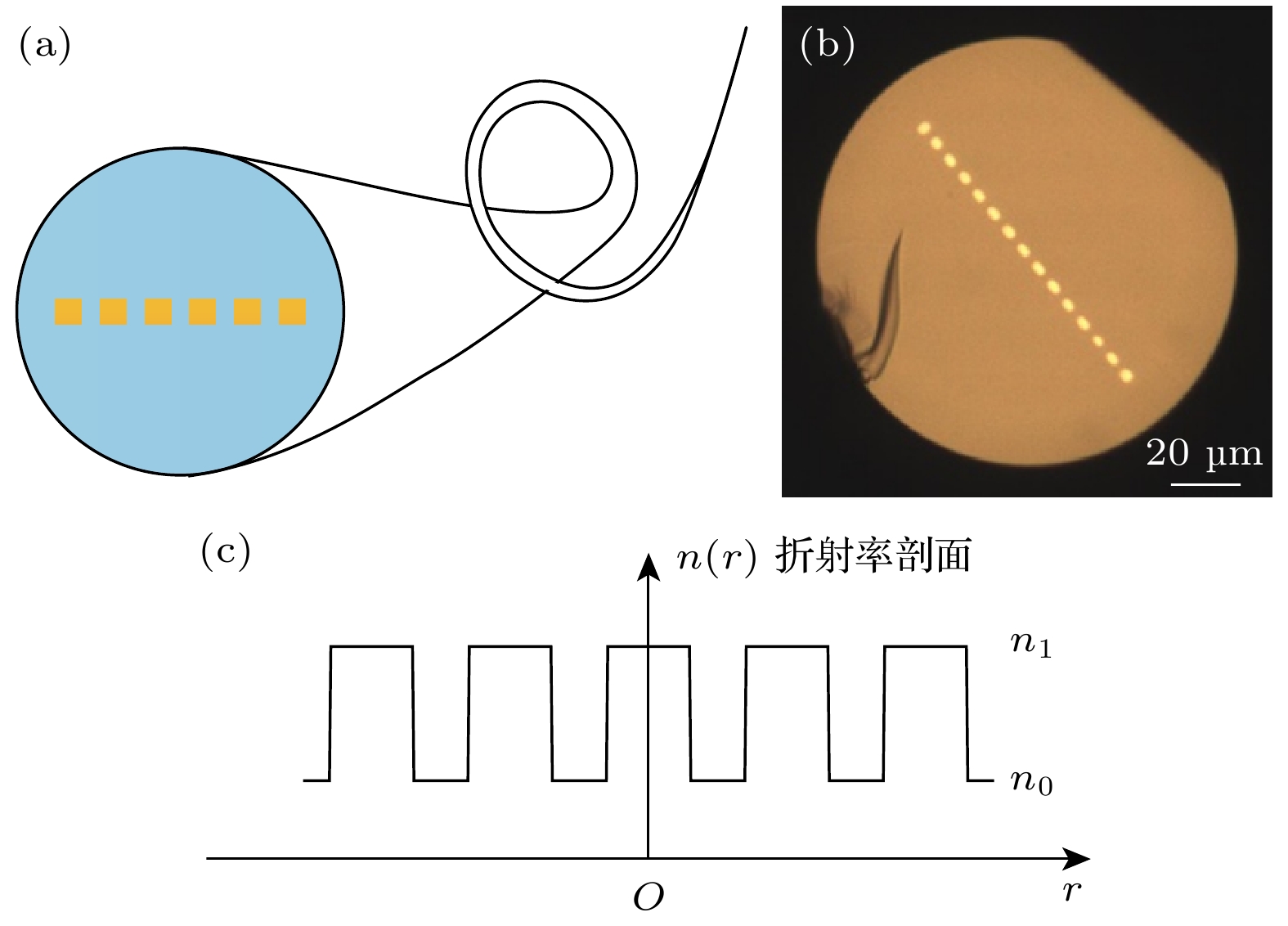
 DownLoad:
DownLoad:
